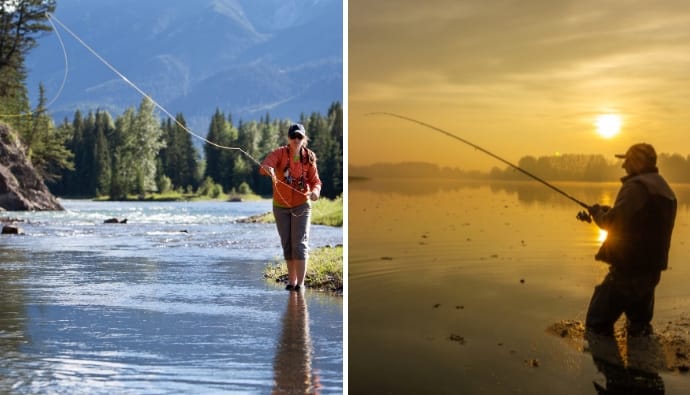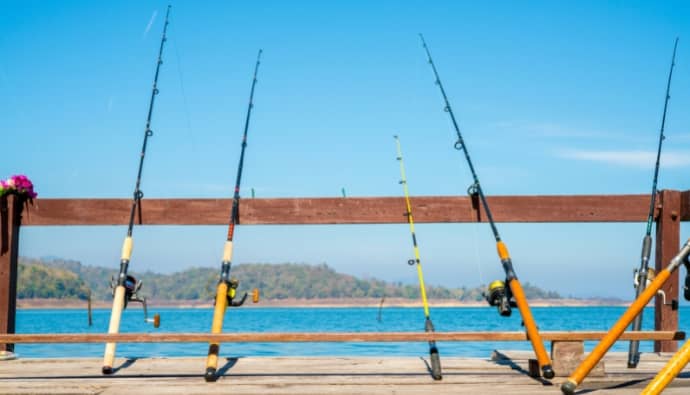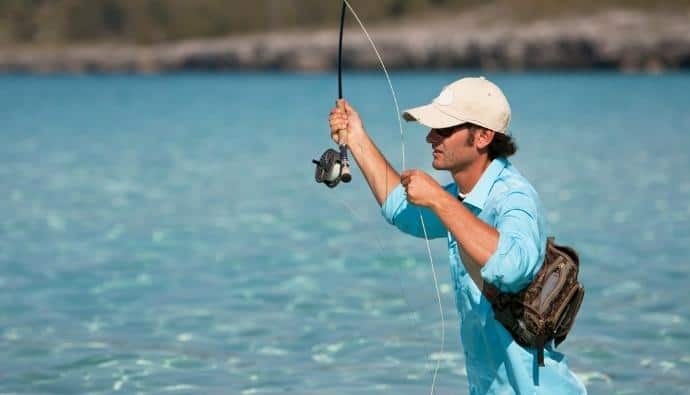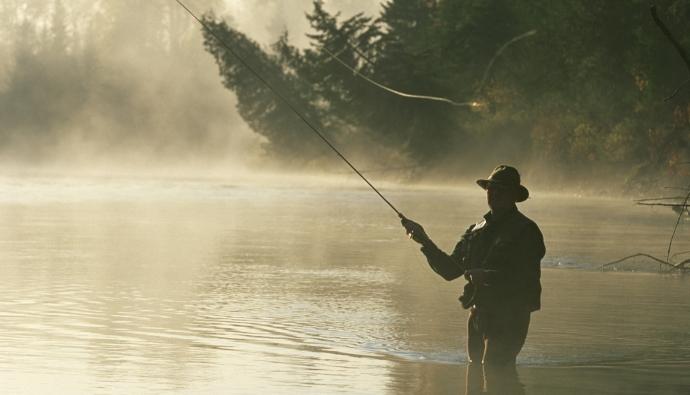Tenkara is a fishing method that originated in Japan and has gained popularity in the USA. It strips fly fishing to the basics. The technique excels at catching trout and char in small mountain streams. It employs fixed casting line lengths fastened to the rod tip, relatively long telescopic rods, and wet, dry, and nymph fly options. In his book Simple Fly Fishing, Yvon Chouinard outlined many of the tenkara fishing techniques we’ll cover in this article.

Tenkara Fishing Tools
Tenkara fly fishing requires a level line, a tippet, a tenkara rod, and a fly.
Tenkara Fishing Rods
Tenkara rods and Western fly rods differ significantly. First, tenkara rods are telescopic, meaning they don’t split into many pieces; instead, they collapse into the rod’s butt part; thus, they are the ideal backpacking fishing rods.
Most tenkara rods have lengths between 10 and 15 feet. The length helps you find the exact trout’s location. At the rod’s tip, a flexible fiber offers more flex to the rod. Besides, all tenkara rods are super lightweight to prevent fatigue.
How to Set Up a Tenkara Rod
Setting up a tenkara rod is frustrating, especially for starters, but it is easy and quick. You must be more careful since many rods break during setup or collapse.
Please note that whenever you want to detach or attach the casting line, keep the rod tip inside the rod’s handle. When extending the rod, start from the thinnest part to the thickest. To collapse the rod, begin with the butt/handle segment and move from the widest to the narrowest.
Using a long rod and light lines ensures a significant dead drift. Tenkara rods help to keep your tippet and fly in the water, reducing the likelihood that the current will pull the line and cause unnecessary drag on the fly.
Tenkara Line Setup
Tenkara fishing uses two fishing line types: tapering woven line and fluorocarbon level line. It is advisable to use the fluorocarbon line as it will help you detect strikes faster—a more sensitive line increases strike detection, enabling you to catch more fish.
Tenkara lines are measured in weight like Western fly fishing. The safe #4 or #5 line weights are typically the best option for beginners, but as you gain skills, you must try using the #1 or #2 weight.
How Do You Identify Strikes When Tenkara Fishing?
The thrilling moment is when the fish takes the fly. The big question is, how do you know? Ensure you use a light fly since the fish needs to go up and bite it.
In most cases, it is assumed that you are fishing in clear water, and you will see the fish grasp the fly. However, this is not always the case. If you are casting deeper and the water is unclear such that you can’t see below the surface, you need another way to identify the strike.
The only option is to use your entire line as a strike indicator. Here you will look at the colored casting line and the tippet.
Tenkara Fishing Flies
Tenkara flies are crucial as they are meant to attract rising fish. The most exciting thing about tenkara fishing is that you can use any fly.
Most Japanese tenkara anglers use only one fly type and adjust their fishing method depending on the environment. Dry, wet, artificial, and all-purpose fly are the common tenkara flies.
Many tenkara dry flies don’t have legs, tails, and wings. They are less realistic and more impressionistic, and they perform better due to solid presentation than mimicking.
Artificial flies imitate aquatic insects that fish feed on. For example, the elk hair caddis mimics natural caddis.
Tenkara wet flies feature reverse hackle that gives them a vibrant, lifelike presentation in the water. Choose flies that are eye-catching and intriguing instead of ones that mimic any specific bug.
Many anglers prefer a single wet fly and avoid using weighted flies. Unlike Western flies, in the traditional tenkara Japanese flies, the hackle is set facing forward.
Tenkara stiff hackle flies employ dry fly hackles to generate resistance in the water instead of absorbing water and undulating fluidly.
Size 12 makes the best all-purpose flies, but you can buy a bigger fly if the water is not clear or flowing fast. Besides, you can make your own flies and use them for fishing. They will help you better understand what trout like to eat and how they behave at various periods of the year.
Tenkara Fishing Tricks and Tips
Most tenkara anglers get confused once they get on the water. They may have better gear, but the most disturbing thing is how to cast a fly effectively. The following are some of the best tenkara presentation techniques that will take you from a starter to an experienced tenkara angler.
Get a Tenkara Lesson
Taking a guided lesson will help you learn the process of setting up the rod, casting options, identifying the trout hiding spots, and what to do after catching a fish. After grasping all these tips, make sure you continue practicing, and you will land fish soon.
Although tenkara is simple than traditional fly fishing, being coached on a stream or river will enhance your learning procedure. You can also read guidebooks and fly fishing books to get more tips.
Even if you don’t immediately catch fish, keep trying without giving up. Keep learning new fishing skills daily; you will be a pro with time.
Get Knots You Can Easily Recall and Rely On
Knots are available in thousands, but you only need to know a few. You only need to know at least three reliable knots. The most common knots in the market are the triple surgeons’ knot, an arbor knot, and a modified cinch knot.
Put on Your Polarized Sunglasses and Ensure Your Feet are Dry
You must wear polarized sunglasses to ensure you see fish and fly underwater. They also help to block glare and protect you from harmful UV rays.
Wear earth-toned clothing or sky, and make sure you remain out of the water. When stalking the fish, ensure they don’t see you. If possible, try not to wade to avoid scaring the fish.
Dead Drift the Fly
Dead drift is the standard way for fishing most flies. Dead drifting is the most straightforward presentation technique that naturally delivers the fly to the fish, whether using tenkara or not. If you want to do a dead drift, toss your fly upstream at an angle and follow it with your rod until it strikes a fish.
If you have a drag-free drift and high stick nymphing, you increase your fishing tenkara-type success.
Throw Away the Fly
“Sutebari” is a Japanese tenkara technique, which means tossing the fly. The method involves casting or throwing the fly to several locations upstream, where a fish is anticipated to be.
The main objective is to get the fish’s attention while there is no drift—just a very brief touchdown and an extremely rapid pick-up. After casting at the projected fish location, an instant strike is anticipated.
For this technique to be successful, toss such that the fly lands first and gently. Once the fly lands, take it up again right away. If you slam the line down on the water’s surface, you will ruin the illusion.
Use a Short Line
The most common mistake many tenkara anglers make is trying to throw a tenkara rod and line with an exact replica of a fly line and fly rod. Using a shorter line will make casting and controlling the line easier.
Using a long line can make you lose a trout swimming toward you. The only way to maintain that tautness on the line is to sprint backward or beside the river. It’s also incredibly awkward to bring a fish in on a long line without a fly reel; you’ll probably get tangled!
Make sure you cast upstream and let the fly softly splash on the water before tracking it. This gives an attractive trick to a hungry fish.
Learn How to Read Water
To be successful in tenkara fishing, you must know how to read water and identify where trout are hiding. If you don’t do so, you will spend many hours on the water without catching fish.
You should pay attention to mountain streams and rivers, hanging or submerged vegetation, in between rocks breaking the flow, and boundaries between slow and fast water. All these areas are worth throwing your fly, and most likely, you will land a fish.
Conclusion
Tenkara is an exciting, simple fly fishing that gives a fantastic experience to beginners. It makes every fly fishing trip successful since it’s rare to go home empty-handed. Unlike traditional gear, tenkara gear is affordable and suitable for backpacking.
Using the above tenkara techniques will help you improve your fishing capabilities. Get the best tenkara rod, such as the Tenkara USA Fly Rod, to increase your success rate.



 Facebook
Facebook YouTube
YouTube








